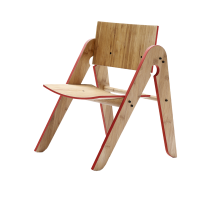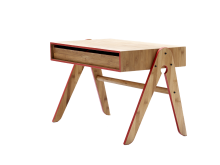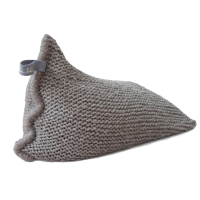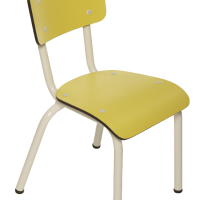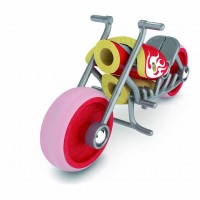Lilly’s Chair and Geo’s Table are clever, classic, and surprisingly colourful. What makes this pair even more of a talking point is that they are made from bamboo.
The Lilly of the chair’s title is in fact designer Sebastian Jorgensen’s daughter, for whom the chair was built when she was two. And this piece became the basis of the company’s entire furniture range including the matching Geo’s Table, which is not simply a beautiful table, but also a functional desk with a large pull-out drawer.
There are references to Eames and Wegner in the geometric angles and curves, and from the front of the chair, the fine colour detailing along the edges of the legs offer the optical illusion that these are delicate bars instead of curved wedges of bamboo
Both the desk and the chair come in black, red or blue edging and are designed for children ages one to five; they are flat packed and have been designed to be easily assembled at home.
Designers and furniture-makers Menrik Thygesen and Sebastian Jorgensen met while studying, and founded We:Do:Wood in 2006. Their first project was a series of specially designed kitchens, but Lilly’s Chair became the basis of the company’s furniture range, which so far comprises a dining table, a lounge chair, stool and shelving system, a swing as well as this Geo’s Desk and Lilly Chair for children, all produced using bamboo.
“For us it begins with the material,” explains Thygesen. “Ethics and aesthetics must go hand in hand. And the opportunities are endless. Once we started investigating a material like bamboo, we couldn’t walk away from it. Bamboo recirculates far more CO² than Nordic types of wood, which have traditionally been used in Danish furniture. Then it’s a question of, for example, reducing the amount of glue in the products, and last, but not least, the good thing about a nice piece of furniture is that you don’t want to get rid of it. And that quite definitely is a resource-saving function!”
Designer Details We:Do:Wood was established in 2006 by Henrik Thygesen and Sebastian Jorgensen in Denmark. The design process usually starts with one of Sebastian’s sketches or models, which the two designers then develop together – generally paring the design down the the bone and focusing on the simplest idea. For We:Do”Wood, functionality is the key, and products must fit into people’s everyday lives and spaces. There is also a strong vision of sustainability that permeates their work. ” We don’t see the concept of sustainability as a passing phase, we view it as our very foundation,” explains Henrik Thygesen.

